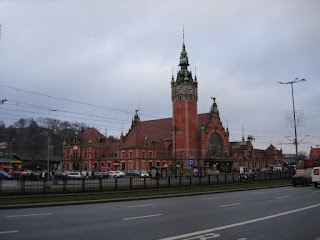
I know what you're thinking.....Gdansk, the city of industrial shipyards and Solidarity strikes - gorgeous? YES! I didn't really believe the tour books that said it was second only to Krakow as Poland's most appealing city, but it truly is one of the loveliest cities we have seen so far in Poland. (I think John would say it's the most picturesque). In many ways it reminds one of Amsterdam and, in fact, the architects for much of the old town area were Dutch/Flemish. In the 16th and 17th centuries, Gdansk (guh-DANGSK) was Poland's wealthiest city, owing largely to its location where the major river Wisla (pronounced VEES-wah, though we call it the Vistula in English) meets the Baltic Sea, and this prosperity resulted in a tolerant, progressive and beautiful merchant city.

The 15th century crane, used for loading ships, is considered the symbol of Gdansk
Gdansk has a rather international history: it was seized in the 1300s by the German Teutonic Knights, who "subdued" the native Prussian population and called the city Danzig. (More about the Teutonic Knights later.) In the late 1300s, the city joined the Hanseatic League, a trade federation of mostly Germanic merchant towns and by the 15th century it was a leading member of this network, which virtually dominated trade in northern Europe. In the mid-1400s, the people of Gdansk rose up against the Teutonic Knights and it became a semi-independent city-state with loose ties to Poland. The city flourished in the 16th and 17th centuries, often called its Golden Age. When Poland was partitioned by its neighbors in the late 18th century, Gdansk again became part of Prussia (later Germany) and was again called Danzig. After WWI, it became an independent city-state, part of the "Polish Corridor" connecting it to Polish lands and effectively cutting off Germany from its northeastern territory. In 1939, Hitler started WWII when he invaded Danzig/Gdansk to bring it back into German hands. After WWII, Gdansk officially became part of Poland and was reconstructed to replicate its golden age (since nearly 80% of the city was destroyed during the war). In 1997 Gdansk celebrated its 1,000 birthday with a wave of renovation and refurbishment, which has left the atmospheric old town looking great!

The Gdansk Armory - a "pearl" of Renaissance architecture

Mariacka (mar-ee-AHTZ-ka) Street

"Arthur's Court" - the medieval version of the businessmens' club (named after King Arthur)
Just another house on the main square!There is no way I can post enough pictures to give you a feeling for how lovely this city is. Of course it helped a lot that the weather was much nicer than during the last trip we took (to southeastern Poland). John says I should say it was "gdamp" when we were in Gdansk, but there really wasn't much rain. The B&B we stayed in (the Gotyk - supposedly the oldest house in Gdansk) was also nice - small, well-decorated, with modern plumbing, right in the middle of the old town (though we did lose power a few times because of all the construction going on). From our bathroom window we looked right at the "largest stained glass window in Poland" which is in St. Mary's Church - the biggest brick church in the world (most large Gothic churches are stone), built in the 14th and 15th centuries and still retaining many of its original decorations (a few days before WWII broke out, locals hid precious items in the countryside).

The beautifully carved main alter and large stained glass window of St. Mary's Church

The magnificent "crystal" vaulting of St. Mary's Church.


Gotyk House B&B


Gotyk House B&B
Calling this area the old town is misleading, since it is a very active part of the city's normal activity. And to be accurate, this section of town is really the Main Town. Each morning I would watch people walking to work from the window of our room. It's not some "museum" for tourists, but an active, beautiful city. ALTHOUGH.....there are amber stores all along several streets (including Mariacka, where our B&B was located). This area of Poland is known as the "Amber Coast" and 75% of the world's amber is mined here, so of course I had to buy some as a souvenir. Did you know that amber comes in white, yellow, green, brown, black and all shades in between? That it is both clear and opaque and the only thing that makes one piece more valuable than another is if there's a bug stuck in it? (It is petrified pine-tree sap.) There's actually so much of it all over - including great big chunks of it - that it gets to seem rather common. (I didn't let that stop me though.)
Even the Gdansk train station is impressive.

And, yes, there are shipyards in Gdansk. Here, the monument to the shipyard workers who died during the protests that eventually helped end communism in Poland.


No comments:
Post a Comment